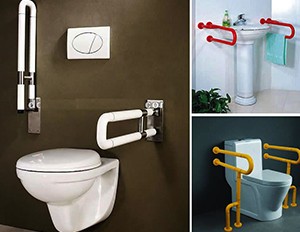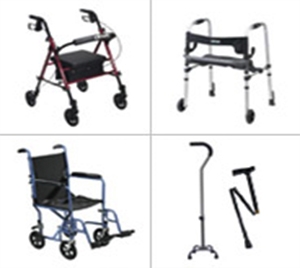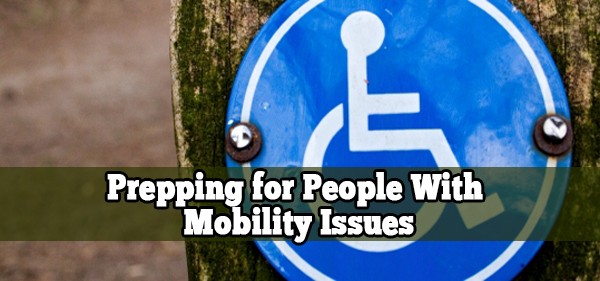This is the third article from the 7-week series on prepping for disabled and elderly. Here is the first article and the second article.
Mobility impairments are the most common impairment for those that are disabled or elderly. In prepping for those with mobility impairments, you should realize that unless it is a recent injury or surgery that has caused this disability, then the impairment will typically remain the same or worsen. This is important to remember because long-term prepping usually covers the worst case scenario. If you plan for someone that can navigate stairs with a little assistance and that condition worsens (when lumber is not available), then you set the disabled individual up for a diminished quality of life. If you install a ramp for those with mobility issues while the lumber is still available, then you have ensured that quality of life. Additionally, in a grid down situation, you never know when you or one of your loved ones may become injured and may then have mobility issues. By planning ahead and prepping for some of the more common issues, it may go a long way in getting you or your loved one through a tough time.
 If your loved one (or you) has a mobility issue that involves walking and is currently mobile, you may want to consider a worst case scenario that they may not be mobile in the future. The simple purchase of a wheelchair to get them in an out of a house might be a good investment. It also would be a good investment in case someone needed it during a CHTF (Crap Hits the Fan) situation. You should also consider purchasing or building handrails for the bathroom and next to beds, elevation seats for toilets, and various other equipment that might be needed if a disability worsens. Whether making or purchasing handrails, they should be rated and attached in such a way that they will hold at least twice the weight of the heaviest person who will most likely be using them. When mounted, they should be attached to the wall in areas where they are most likely to be used. If the individual who might need them does not currently live with you, or you are considering a future problem, you can purchase these in advance of a CHTF situation, and add them to your stockpile. When the need arises, you will have the handrails on hand and be able to mount them where they are needed.
If your loved one (or you) has a mobility issue that involves walking and is currently mobile, you may want to consider a worst case scenario that they may not be mobile in the future. The simple purchase of a wheelchair to get them in an out of a house might be a good investment. It also would be a good investment in case someone needed it during a CHTF (Crap Hits the Fan) situation. You should also consider purchasing or building handrails for the bathroom and next to beds, elevation seats for toilets, and various other equipment that might be needed if a disability worsens. Whether making or purchasing handrails, they should be rated and attached in such a way that they will hold at least twice the weight of the heaviest person who will most likely be using them. When mounted, they should be attached to the wall in areas where they are most likely to be used. If the individual who might need them does not currently live with you, or you are considering a future problem, you can purchase these in advance of a CHTF situation, and add them to your stockpile. When the need arises, you will have the handrails on hand and be able to mount them where they are needed.
When considering the needs of mobility devices, you should not forget extra batteries, which was mentioned last week. Another consideration for mobility devices might be a tire patch kit or a spare tire in case one goes flat. You could also consider a can of fix-a-flat (or other tire repair foam), however nobody has ever researched the issues that it may cause with a mobility device and it may not be useful if the tire has a large chunk taken out of it. Don’t forget that you should also have a method of adding air (such as a tire pump), once the tire is repaired.
Prosthetics are perhaps the one item when preparing for grid down mobility issues that would not be useful to anyone but the person that wears them. Because they are custom fit, only the person that was fitted for this prosthesis would be able to use it. Even though only one person would be able to use it, if the individual has multiple prosthetics, or they have been fitted with a new prosthetic, save the older one in case the prosthetic that they normally wear becomes damaged in a grid down situation. The exception to this would be the case where the older prosthesis does not fit or causes skin and/muscle problems. If the individual does not have a spare, talk to your medical doctor about getting a spare or new prosthetic, especially if the disabled person has had prosthesis over a year. Replacement of prosthetics varies from person to person based on their activity level and various other factors, but research has shown that prosthetics are often replaced annually.
 The gathering of canes (including quad-canes), walkers, crutches and other mobility devices is also recommended for those with mobility issues and those that may need them in the future. For those that use mobility devices already, having a spare might make a huge difference in their quality of life. If a doctor requires an upgrade from one device to another, such as upgrading from using a cane to using a walker or quad cane, save the old device rather than selling it or throwing it away. In some instances, insurance companies will approve upgrading to a new device when a mobility device reaches a certain age. Should this be available, take the upgrade and store the old device for an emergency. If someone in the family suffers an injury and gets a pair of crutches from the hospital save those crutches for those that are mobility impaired or that may become mobility impaired in a CHTF situation.
The gathering of canes (including quad-canes), walkers, crutches and other mobility devices is also recommended for those with mobility issues and those that may need them in the future. For those that use mobility devices already, having a spare might make a huge difference in their quality of life. If a doctor requires an upgrade from one device to another, such as upgrading from using a cane to using a walker or quad cane, save the old device rather than selling it or throwing it away. In some instances, insurance companies will approve upgrading to a new device when a mobility device reaches a certain age. Should this be available, take the upgrade and store the old device for an emergency. If someone in the family suffers an injury and gets a pair of crutches from the hospital save those crutches for those that are mobility impaired or that may become mobility impaired in a CHTF situation.
If your mobility impaired loved one uses leg braces, back braces, arm slings, or any other support device, having spares is also advisable. Much like walkers, insurance companies allow new devices based on their schedule. Ask the insurance company or your medical doctor when replacement is allowable and store either the new one or the old one. In some cases, these devices are the common braces found at your local pharmacy. If funding is available, those over the counter braces could be purchased to assist in a CHTF situation for the mobility impaired or for the possibility that someone could become mobility impaired.
Related: Where to buy Survival Antibiotics without Prescription?
Another useful tool for mobility issues, especially those that are back or shoulder related, is called a Bottom Buddy. A Bottom Buddy (brand name) is relatively inexpensive and is used to wipe when you are incapable of reaching your bottom or groin area for personal hygiene after using the bathroom. It provides an extension to your arm that accepts and discards toilet paper and washcloths without getting your hands dirty.
While many books could be written to cover mobility issues in a CHTF situation, it would be nearly impossible to cover every situation. The best way to deal with mobility and other disability and elderly related issues is to think of the worst case scenario, then make it even worse by thinking about what you would do if your equipment and devices became inoperable. As always, you should test any new prepping measure to make sure they work. Imagine thinking you bought the perfect wheelchair at a good price, then in a CHTF situation, you find that it will not fit through the doors in your house. Prepping without testing will set you up for more challenges and possibly even failure during a CHTF situation.
Also from this series:
Prepping to Power Medical Equipment When SHTF
Prepping for Disabled and Elderly Populations
You may also like:
EMP Myths and Facts. What’s BS and What’s True?
H2O Dynamo – The Awesome Device That Turns Air Into Fresh Water! (Video)
Burdock: The Annoying Weed That Can Save Your Life
About the Author: Russ Fuller is not this contributor/authors real name. The author is an avid prepper who is well-known in the public safety field. He uses a pen name to protect his identity due to the stigma that surrounds prepping and survival from those that are not preppers. He feels this stigma could damage his reputation, credibility, and his employment in public safety. In his job, he helps disabled and elderly individuals prepare for short-term disasters and is considered a subject matter expert in the field.
Disclaimer: The information contained in this series is for informational purposes only. A medical professional should be consulted before taking any actions. It should also be noted that due to the varying levels of knowledge among preppers, this series will explain the most basic actions that can be taken through advanced levels of preparedness.
















At seventy five and still moble but see the signs of myself slowing down and my stamina wainning, I see artacles like these and welcome the realisation that we have a choice. I asked the queston at a meeting if any could leave a family member behind. Well everyone was shocked and couldn’t fathom doing so. Then I asked what if it put the remainder of the family’s future survival in question. To put a senior in harms way or a child. If you cant answer then you are not prepared. I told them that we don’t have much difference in caring for a child or a senior. I stood in front of people sitting in total silence. Sometimes it takes the grouchy old man to stand and voice things others push out of thought to deny it will ever happen. Telling ones self it cant happen doesn’t make it so.
Grampa
Grampa,
You my friend are a refreshing breath of air. So many in our society want to stick their head in the sand and say “it will never happen to me”! Worse yet, there are a certain amount of people that believe the government will take care of them. Let’s face it, as much as local, state, and the federal governments may want to help, if it really hits the fan, there are not enough first responder’s or money in place to take care of everyone. Furthermore, the elderly and disabled will probably take a lower priority in one of these types of situations. I encourage you to continue to be a beacon for those that are in the dark. Find articles to give to them, whether it is my series or some other article that is similar, and help them to see the light. I believe it was the author Wayne Trottman who said “If you bury your head in the sand it will only lead to suffocation”. Keep sounding the alarm before these people suffocate, … Russ
Yes